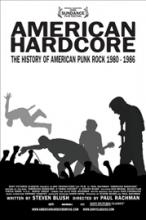Yes, the book American Hardcore preceded the film of the same name by about five years. But author Steven Blush teamed up with a buddy – director Paul Rachman who made a name for himself working on music videos – to produce the filmic version of the book.
In reading Blush’s work, it’s easy to be drawn into an historical trek through major hardcore scenes across the country. Illustrated by show flyers, album covers and set lists, the book moves at a quick clip. But that’s to be expected when considering the music covered therein.
A few easy criticisms arise, neither of which matter too much and really come down to trivial concepts, but apply both the to the film and the book. Firstly, the inclusion of Social Distortion is troublesome even if only the earliest moments of the band’s history is included. Mike Ness and company did appear (star?) in Another State of Mind alongside Youth Brigade. But apart from that connection to the scene and simply being from SoCal doesn’t make a strong case for inclusion. Secondly, and probably only important to native Ohioans is the fact that the Necros were from a suburb outside of Toledo and weren’t spawned in Michigan despite where the band wound up. Trivial? Yes, but historically accurate.
Working on projects of this ilk, though, unquestionably found Blush and Rachman, both veterans of the scene, in scenarios where stories related by different subjects conflicted with one another. So, while it’d be nice to figure American Hardcore, in whatever form, as a definitive guide to hardcore’s birth, there’re probably more than a few folks that don’t agree with what wound up being included and conversely, what was excluded.
Surprisingly, there’s very little shit talking. Of course, Harley Flanagan has a few choice words for the Boston Crew. And while there was obviously violence inherent in the scenes most of it was centered around the various punk gangs that sprung up in Southern California. It’s an odd concept to grasp, but in a city that large, it would make sense if finding protection became a necessity. Usually, though, folks figure the bonehead portion of the scene to come out of the Northeastern parts of the country. Either way, catching an elbow or a fist in the face was part of going to a show. And that’s what was hard to relate to the straight news media at the time.
Now, that’s no longer necessary with movies (and books) like this. And obviously with the underground expanding to the point that it doesn’t know what to do with itself any more, there probably won’t be another movement like this – well, maybe ever. Bummer. But a nostalgic one.
